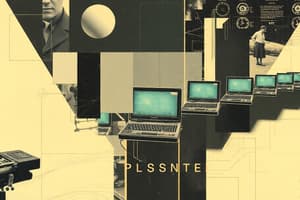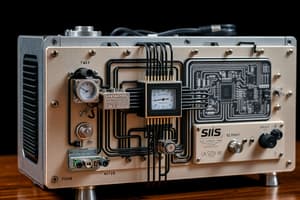Podcast
Questions and Answers
What is the primary function of a universal Turing machine?
What is the primary function of a universal Turing machine?
- To execute any computation given the proper program. (correct)
- To process data without any programming knowledge.
- To perform specific calculations very quickly.
- To manage hardware resources efficiently.
Which statement accurately describes the relationship between powerful computers and universal Turing machines?
Which statement accurately describes the relationship between powerful computers and universal Turing machines?
- Both can perform the same computations regardless of their architecture. (correct)
- Powerful computers are less flexible than universal Turing machines.
- They can only perform the same computations with limitations.
- A universal Turing machine can perform computations that powerful computers cannot.
In the von Neumann model, how are programs treated in relation to data?
In the von Neumann model, how are programs treated in relation to data?
- Programs and data are logically equivalent and stored in memory. (correct)
- Programs are physically separate from data.
- Programs cannot be stored in the computer's memory.
- Programs must be stored in external devices.
What are the four subsystems of a computer based on the von Neumann model?
What are the four subsystems of a computer based on the von Neumann model?
In the provided diagram description, what is the output of the 'Find smallest' operation?
In the provided diagram description, what is the output of the 'Find smallest' operation?
Flashcards
Universal Turing Machine
Universal Turing Machine
A theoretical machine that can perform any computation, given the right program.
Von Neumann Model
Von Neumann Model
A computer design where both programs and data are stored in computer memory.
Four Subsystems
Four Subsystems
The four main parts of a von Neumann computer: memory, Arithmetic Logic Unit (ALU), control unit, and input/output.
Arithmetic Logic Unit (ALU)
Arithmetic Logic Unit (ALU)
Signup and view all the flashcards
Computer Memory
Computer Memory
Signup and view all the flashcards
Study Notes
Universal Turing Machine
- A universal Turing machine can perform any computation given a proper program.
- This was the first description of a modern computer.
- A powerful computer and a universal Turing machine can perform the same computations.
- Providing the data and the program (how to compute) to either machine enables the same computation.
- A universal Turing machine can compute anything that can be computed.
Von Neumann Model
- Computers built on the Turing machine store data in memory.
- In 1944-1945, John von Neumann proposed that program and data are logically the same.
- Therefore, programs and data should be stored in a computer's memory.
Four Subsystems of the Von Neumann Model
- The von Neumann model divides computer hardware into four parts:
- Memory
- Arithmetic Logic Unit (ALU)
- Control Unit
- Input/Output (I/O)
Studying That Suits You
Use AI to generate personalized quizzes and flashcards to suit your learning preferences.




